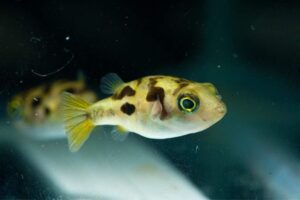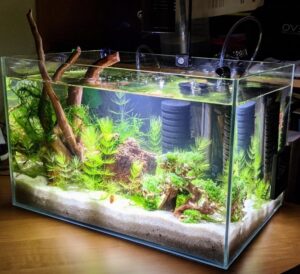
Java Moss Vs Flame Moss: Differences Explained

Writer at The Aquarium Keeper
It can sometimes be difficult to choose the right plant for your aquarium. Moss plants are very confusing since most of the time it is very hard to tell the difference between two different mosses. This can be a serious problem because some mosses are needier in aquariums than others. In this article, I will break down the differences between these two species. Reading this article will help you with choosing java moss or flame moss.
Java Moss Vs Flame Moss
To begin, java moss (Taxiphyllum barbieri) is native to southeast Asia and was only seen growing in the wild in Vietnam. Flame moss (Taxiphyllum sp.) is rather a newly discovered type of moss, that also comes from southeast Asia. Even though flame moss has only been discovered a few years ago, it is widely popular in the aquarium hobby, especially among people, who mainly aquascape. Even though both mosses come from the same part of the world, these two species differ in appearance, water parameters, and many more things.
Appearance
Java moss is a small, soft, green plant that grows sporadically everywhere. It has a very delicate, feathery texture and is usually found attached to rocks and driftwood. This type of moss usually does not grow very large in terms of length. It and rather spreads horizontally, but if left untreated, it can reach up to 5 inches in length.

Java moss is an excellent plant for small aquatic creatures since it mainly grows in big clumps. Due to its density, small fish and shrimp can easily hide. Bigger fish also use java moss as a breeding spot. Java moss does not have roots, it has rhizoids, which help the plant to stay in one place.
Flame moss looks a little different when compared to java moss. Although it has almost the same color as java moss, flame moss has leaves, that mainly grows up, and has the appearance of small flames, hence the name. This particular species of moss does not grow well horizontally, and also does not have roots, instead, it uses rhizoids to stick in one place.

Flame moss is very loved by aquascapers, since it can be used on various decorations, and the growing pattern of this moss makes it look like thick vegetation or even a big patch of grass. Flame moss is one of the best plants for a shrimp tank, or a breeding tank, where small fish like to hide.
Water Parameters and Tank Conditions
Moving on, java moss is considered one of the easiest plants to take care of in the aquarium hobby. It can tolerate a wide range of water parameters, and do well in low-tech and high-tech setups. The ideal water temperature for java moss is 15–27 °C (60–80 °F), while the preferred pH is 5.0 – 8.0. Java moss is a great low light aquarium plant and does not require very strong light, it does best in low to medium lightning. Very strong light can cause algae problems with java moss. There are a lot of aquarium carpeting plants, and java moss is one of the easiest, but it can also be used in all sections of the tank, including attaching to decorations.
Flame moss is also not a picky plant, and can be categorized as beginner-friendly. Although both mosses come from the same regions, flame moss requires different water temperatures and slightly different pH to thrive. The ideal water temperature for flame moss is 20–29°C (68–84 °F), and the best pH is 6.0 – 7.5. Similar to java moss, flame moss does not need very strong light, it can do well in low to medium lighting conditions. Unfortunately, flame moss is not really a good carpeting plant, because it mainly grows upwards, and only shows minimal growth horizontally. It is possible to have a flame moss carpet in your tank, but you would be required to trim your moss and replant it multiple times.
Moss carpets are usually achieved, by using mesh plates. Java moss would take over the entire mesh plate easily, because it grows in all directions, while flame moss would have a harder time achieving that.
CO2 Necessity
CO2 is mainly used to improve the coloration and growth of plants, although some aquatic plant species can’t grow without additional CO2 supply. Java moss is a beginner plant, which means it does not need additional CO2 injections, but it would improve the growth rate and coloration of the plant.
Flame moss is similar to java moss when it comes to additional CO2 injections. It can easily survive without, and CO2 is not required, but it easily can improve a lot of things for this plant. To put it simply into words, Every plant benefits from additional CO2 injections, but it costs more, so if you have a bigger budget, try using CO2 for flame moss and java moss.
Fertilisation Necessity
Lack of nutrients is one of the most popular reasons why aquarium plants are dying. Both flame and java are not very needy plants, but they need nutrients to survive. These species don’t have roots, which means these plants get all their required nutrients from water and light, using their leaves and stems. The best way you can give these plants nutrients is by using liquid fertilizer. There are countless good liquid additives, that have numerous nutrients, which would help these plants grow. Some people can argue, that java and flame moss can grow without liquid fertilizer. That might be true, but it is best to use some sort of liquid additive to aquarium water so that these plants would have more than enough nutrients to grow.
Growth
Java moss is considered a fast-growing plant, and if the conditions are right, it can grow twice as large in a couple of weeks! Flame moss is a little different, and grows significantly slower than java moss.
Maintenance
Moving on, since java moss is a very fast-growing plant, it can require more attention. If you do not take care of your java moss in terms of trimming and maintenance, it can easily spread across your aquarium, covering the substrate, rocks, and driftwood. On the other hand, flame moss is not as time-consuming as java moss, because it simply grows slower, and does not spread that much. Flame moss is very easily maintainable, while java moss needs regular trimming.
Price
When it comes to price, flame moss is a little more expensive than java moss. The reason behind this price gap is availability. Flame moss was only recently discovered, while java moss has been used by fishkeepers for years. You can get a clump of java moss for about 6$, while flame moss costs around 9$.
Reasons Why You Should Get Java Moss
The most obvious reason is the hardness of the plant. Most beginner fishkeepers have a hard time growing and keeping plants alive. Java moss can easily survive in a vast range of water parameters and is very forgiving. It also can be attached to various decorations, including driftwood, and rocks. You can even build a moss wall, using mesh plates.
Reasons Why You Should Get Fire Moss
The main reason why I encourage you to try flame moss is its looks. There is a very little number of plants, that look this cool, and flame moss can bring a lot of eyes to your aquarium. It is also relatively hardy, so you should not worry too much if you are a beginner.
Frequently Asked Questions
Can Java Moss Grow Out of Water?
Java moss can easily grow out of water. Similar to anubias and bucephalandra, java moss has the ability to grow emersed and submerged. If you plan to grow java moss out of the water, be sure that it has enough moisture, since it needs water to survive.
Can Java Moss Grow Floating?
The short answer is yes. Java moss can easily grow while floating since it is not a root-feeding plant. Java moss absorbs all the nutrients from its leaves and stems and does not have any roots. It can also be used as a hiding spot for small fish and shrimp, so you can leave it floating.
Writer's Thoughts
Flame moss and java moss are amazing plants, that improve the looks of every aquarium. In my opinion, every beginner should try to grow these plants, since they really don’t need much to thrive.
If you enjoyed reading our article about java moss and flame moss, please feel free to share it with your friends by clicking the social media buttons below:



Pea Puffer: Adorable Little Hunter, Everything You Need To Know



